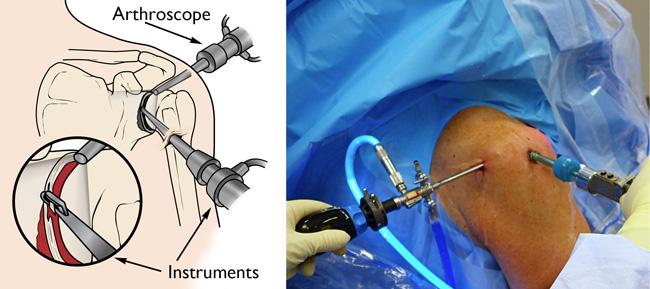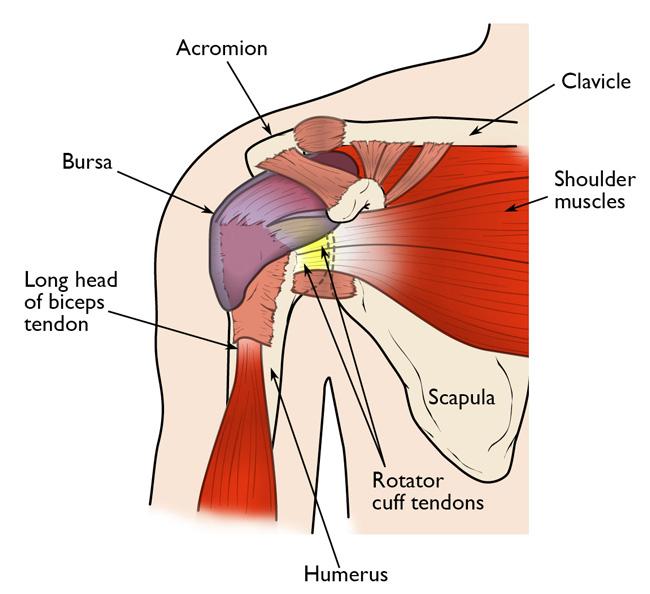What is Rotator Cuff Surgery? How Rotator Cuff Surgery Procedure Go?
What is Rotator Cuff Surgery?
Rotator cuff surgery is a surgical procedure performed to help repair a torn rotator cuff. The shoulder joint is surrounded by a set of four muscles and tendons called the rotator cuff. It provides stability and strength. An injury to the rotator cuff may cause one or more of tendons or muscles found in the shoulder joint to tear off and a surgery procedure may be needed to repair it.

Rotator Cuff Anatomy, Location and Function
Rotator cuff is located within the upper extremity and consists of muscles such as the subscapularis muscle, teres minor muscle, infraspinatus muscle, and supraspinatus muscle. The muscles originate from the part known as scapular and they will insert in the humerus.
The main function of rotator cuff is stabilizing and centering the humeral head within the joint socket referred to as the glenoid cavity. On top of that, the muscles found in rotator cuff help in tightening the joint capsule, something that prevents a pinch when the shoulder moves.
In essence, rotator cuff plays a big role in movement of the shoulder joint. The muscles associated with rotator cuff have different functions, for example, subscapularis muscle helps support the upper arm in time of adduction and abduction.9

Causes of Rotator Cuff Tears
Rotator cuff injuries have four major causes:
- Aging which causes natural wear and tear (deterioration) of the tendon tissues. Rotator cuff injuries are more common in individuals over forty years of age.
- Development of bone spurs in the shoulder bones cause damage or irritation to the tendons.
- An accident can cause acute trauma to the shoulder resulting in a tear of the rotator cuff.
- Continuous demanding activities that entails repetitive arm motions and strain the shoulder muscles e.g. construction work or other intense sports like weightlifting, baseball and tennis can injure the rotator cuff.
When is Rotator Cuff Surgery Conducted?
If your rotator cuff is torn, a doctor may suggest that a surgery be performed, especially if your are having pain and it is not improving after attempting the nonsurgical methods. The main reason why the surgery may be done is when the pain continues to worsen despite receiving treatment. A doctor may also perform a surgery if you a very active individual and you use your arms for things like overhead work or sports activities. There are other things, which may suggest that you have a rotator cuff surgery and they include:8
- If the symptoms have taken more than 6 to 12 months and have not improved
- If the tear is too large say like 3cm or more and the surrounding tissues are in bad shape
- If you are experiencing weakness as well as loss of function within your shoulders
- When the tear was as a result of a recent, acute injury.
Symptoms of Rotator Cuff Tears
Symptoms of rotator cuff injuries depend on the severity of the tear, some people do not even notice that they have suffered an injury particularly very small tears. Symptoms of rotator cuff injury include:
- A dull ache usually felt deep in the affected shoulder.
- Trouble sleeping if one lies on the injured shoulder.
- General weakness or tiring of the arm.
- Difficulty performing tasks that require straining shoulder muscles e.g. putting on a seatbelt or combing your hair.1,2
Different Kinds of Rotator Cuff Surgery
Surgical methods are recommended if the symptoms have lasted for over six months, the tear is larger than three centimeters, there is loss of function in the shoulder and the tear was recently caused by acute injury e.g. car accident.
There are four major methods for repairing extensive damage to the rotator cuff all of which aim to reduce pain and restore mobility in the shoulder:
All Arthroscopic Repair
As an outpatient procedure, all arthroscopic repair is the least invasive surgical option to treat a torn rotator cuff since it makes small incisions of about one centimeter each for the surgeon to access the torn tendon. It works best for patients with small rotator cuff tears of less than three centimeters.
All arthroscopic repair allows the surgeon to insert an arthroscope (small camera) into the patients shoulder joint then display the camera’s pictures on a video screen. Using these greatly detailed images the surgeon guides miniature surgical instruments that are inserted through portals in the shoulder.
Arthroscopic repair allows for a shorter recovery period, less pain and risk of post operational complications.3,5
Open Repair
This is the oldest method for treating rotator cuff tears and is suitable for large complex tears that may require additional reconstruction e.g. tendon transfer which is performed when a damaged tendon cannot be reattached to the top of the humerus hence a tendon from a different body part (usually the latissimus dorsi tendon of the back) is implanted to repair the rotator cuff.
The surgeon makes an open incision that is several centimeters long over the shoulder. They then detach one of the shoulder muscles (deltoids)in order to reach the torn tendon. They then remove bone spurs from the underside of the acromion in a procedure called acromionplasty.3,5
Mini-Open Repair
This is a combination of the two methods of treatment above (open and arthroscopic repair). Patients who have torn more than one rotator cuff tendon are advised to use this surgical technique.
The surgeon makes a smaller incision than that required in traditional open repair. It is typically three to five centimeters long. The surgeon then uses an arthroscope to assess and cure the damage in the shoulder joint. This method also does away with the need to detach the deltoid muscles as bone spurs (osteophytes) are removed arthroscopically. The surgeon however views the shoulder directly from above and not on a video screen like in all arthroscopic repair.3,5
Shoulder Replacement
Extensive injuries to the rotator cuff typically need shoulder replacement surgery Stability of the artificial joint is increased through an inventive procedure called reverse shoulder arthroplasty. This procedure installs the ball section of the artificial joint into the shoulder blade and the socket section of the artificial joint into the arm bone.3,5
How Rotator Cuff Surgery Procedure Go?
In repairing a torn rotator cuff, the surgery may involve:
- Removal of loose fragments of bursa, tendon, and some other debris from the area or space where rotator cuff moves in the shoulder.
- The surgeon makes more room or space for the rotator cuff tendon and by doing this, it ensures that the rotator cuff tendon is not irritated or pinched when a person moves the shoulder. The procedure may involve removing bone spurs or shaving bone from the shoulder blade point.
- The surgeon also knit the torn edges of the patient’s supraspinatus tendon including the top part of the upper arm bone or the humerus.
While arthroscopic surgery is the said to be the commonest way the surgery may be done, in some other cases, an open shoulder surgery may be required. 8
Risks Associated with Rotator Cuff surgery
Surgery procedures have inherent risks such as loss of blood and issues related to anesthesia, however, surgeons do their best to minimize these risks. Some of the complications that may arise from rotator cuff surgery include:
- Pain and stiffness that doesn’t seem to go away
- Infection may occur on the incision or on the shoulder joint
- There may be damage done to the muscle or deltoid tend – and that means for instance, if deltoid is detached, you may need additional surgery to help repair it.
- Though uncommon, blood vessel and nerves may be damaged8
What to Expect Following the Surgery?
When the surgery is performed, there may be some discomfort, but this may subside as you continue to take the pain medications that the doctor has prescribed. Your arm will remain protected in a sling and this may take some time before it is removed. It is important that you consider having physical therapy following the surgery to help in recovery. In the recovery program, the following may need to be taken into consideration:
- Soon you are out of anesthesia, it is wise you begin mild exercises to help flex as well as extend the hand, wrist, and elbow
- A physical therapist may help you to move your arm or shoulder joint through its range of motion.
- Take part in active exercises aimed at moving the arm by yourself. Stretches with help of a physical therapist may help in recovery and this can begin from the 6th week to the 8th week following the surgery. The nature and extend of the exercises will depend on how bad the tear was as well as the complexity of the surgery repair.
- A few months following the surgery, you may be taught strengthening exercises. In this time, you begin with the light weights and then advance to heavier weights.8
Reference List
- Rotator Cuff Injuries – Causes, Symptoms and Treatment. American Society for Surgery of the Hand: https://assh.org/handcare/hand-arm-injuries/rotator-cuff-injury
- Rotator Cuff Injury – Symptoms and Causes. Mayo Clinic: https://mayolinic.org/diseases-conditions/rotator-cuff-injury/symptoms-causes/dxc-2
- Rotator Cuff Tears: Surgical Treatment Options. OrthoInfo AAOS: https://orthoinfo.aaos.org/topic.cfm?topic=a00406
- Rotator Cuff Injury Treatment. Mayo Clinic: https:// https://mayolinic.org/diseases-conditions/rotator-cuff-injury/treatment
- Different Types of Rotator Cuff Surgery. Sports Health : https://sports-health.com/treatment/shoulder-injury-treatment/
- Preventing Rotator Cuff Injuries. Duke Health: https://dukehealth.org/blog/preventing-rotator-cuff-injuries
- Rotator Cuff Disorders – Prevention. WebMD: https://webmd.com/a-to-z-guides/tc/rotator-cuff-disorders-prevention
- Rotator Cuff Repair. http://www.webmd.com/a-to-z-guides/rotator-cuff-repair
- Rotator Cuff Tears: Surgical Treatment Options. http://orthoinfo.aaos.org/topic.cfm?topic=a00406
